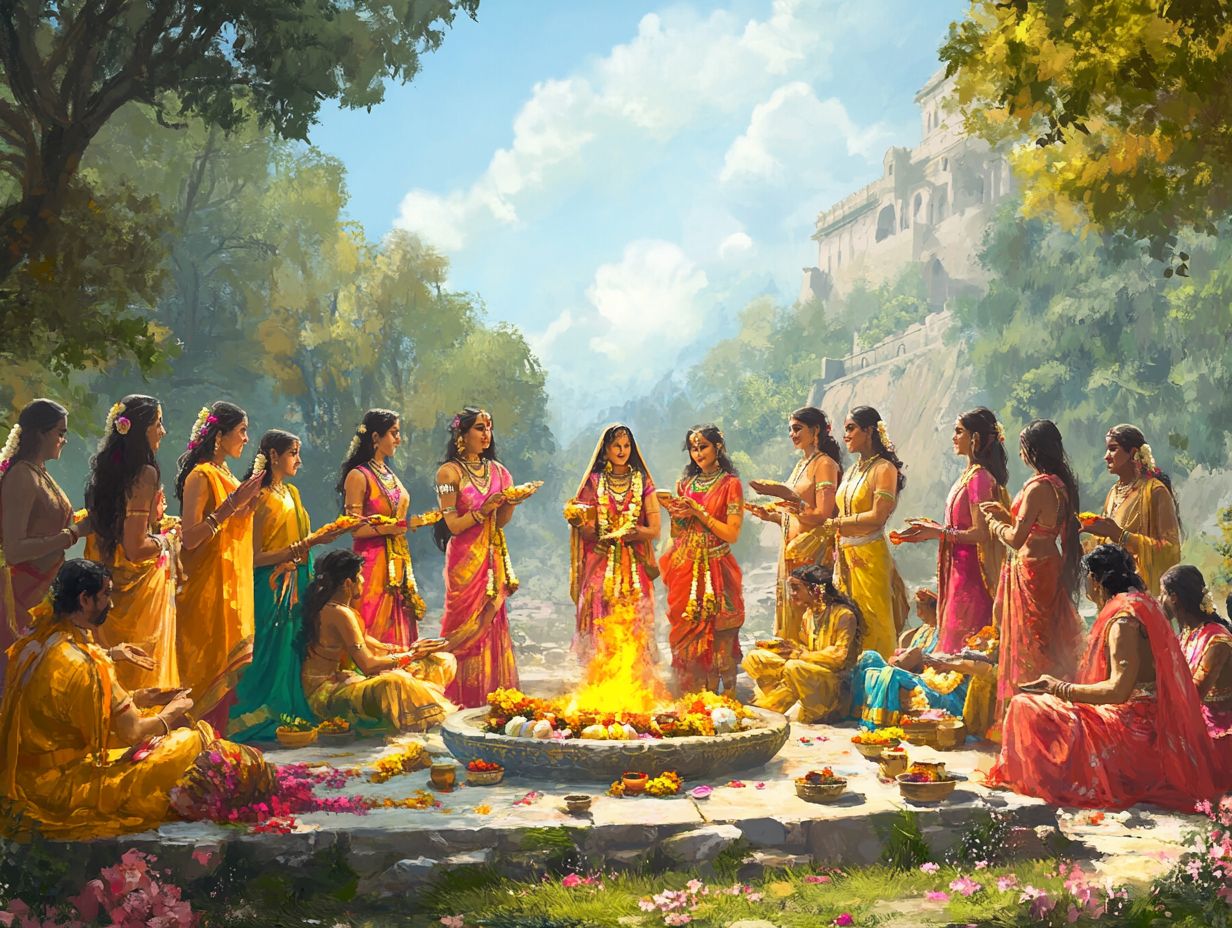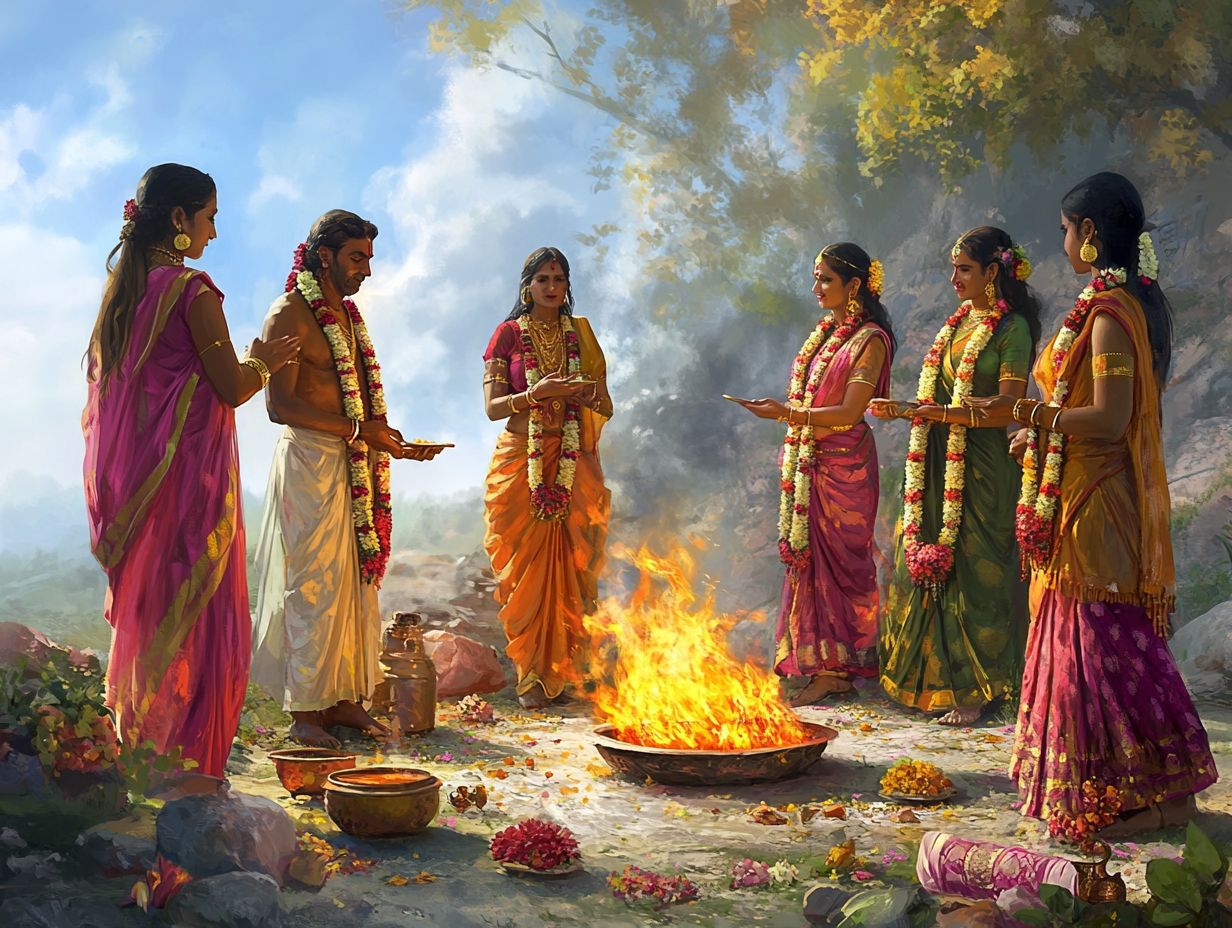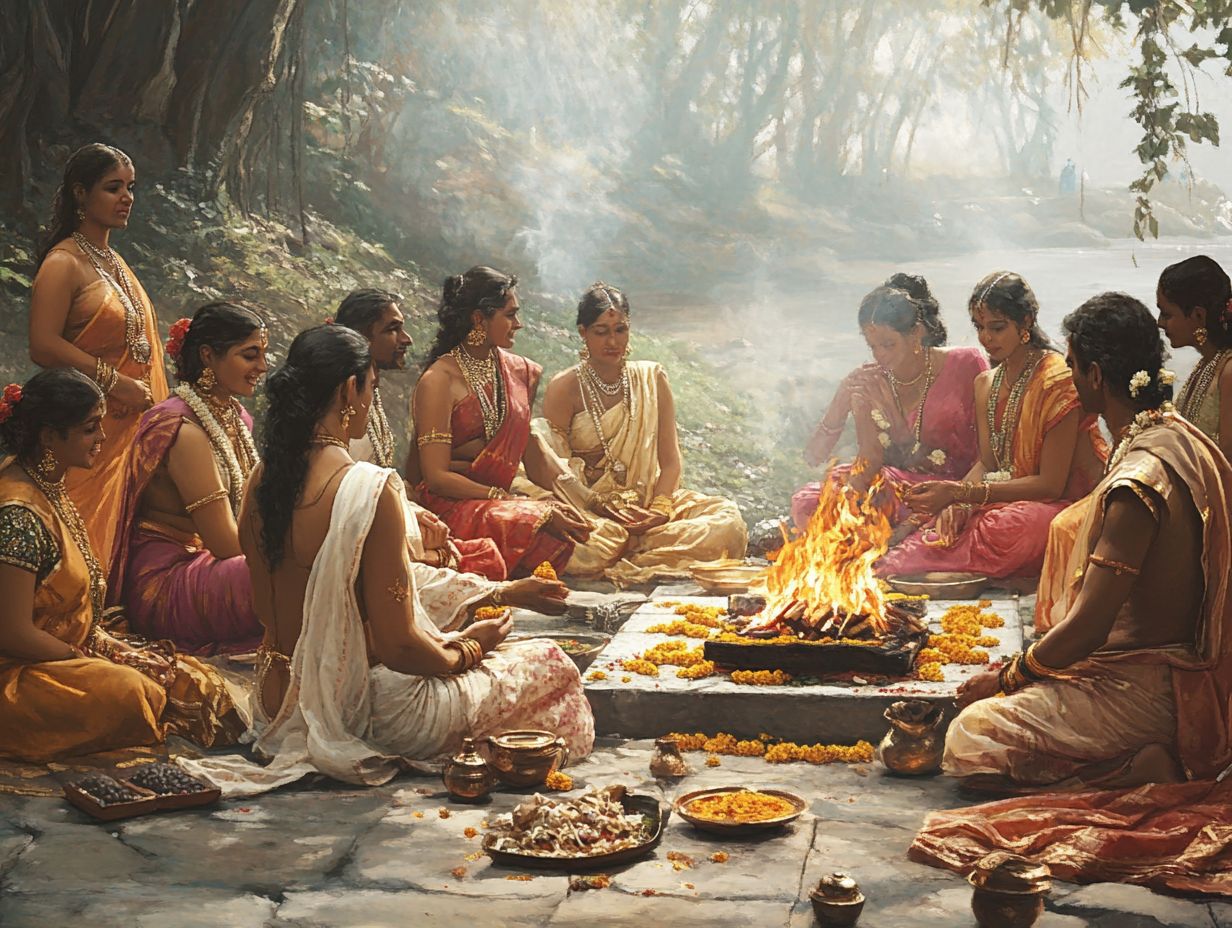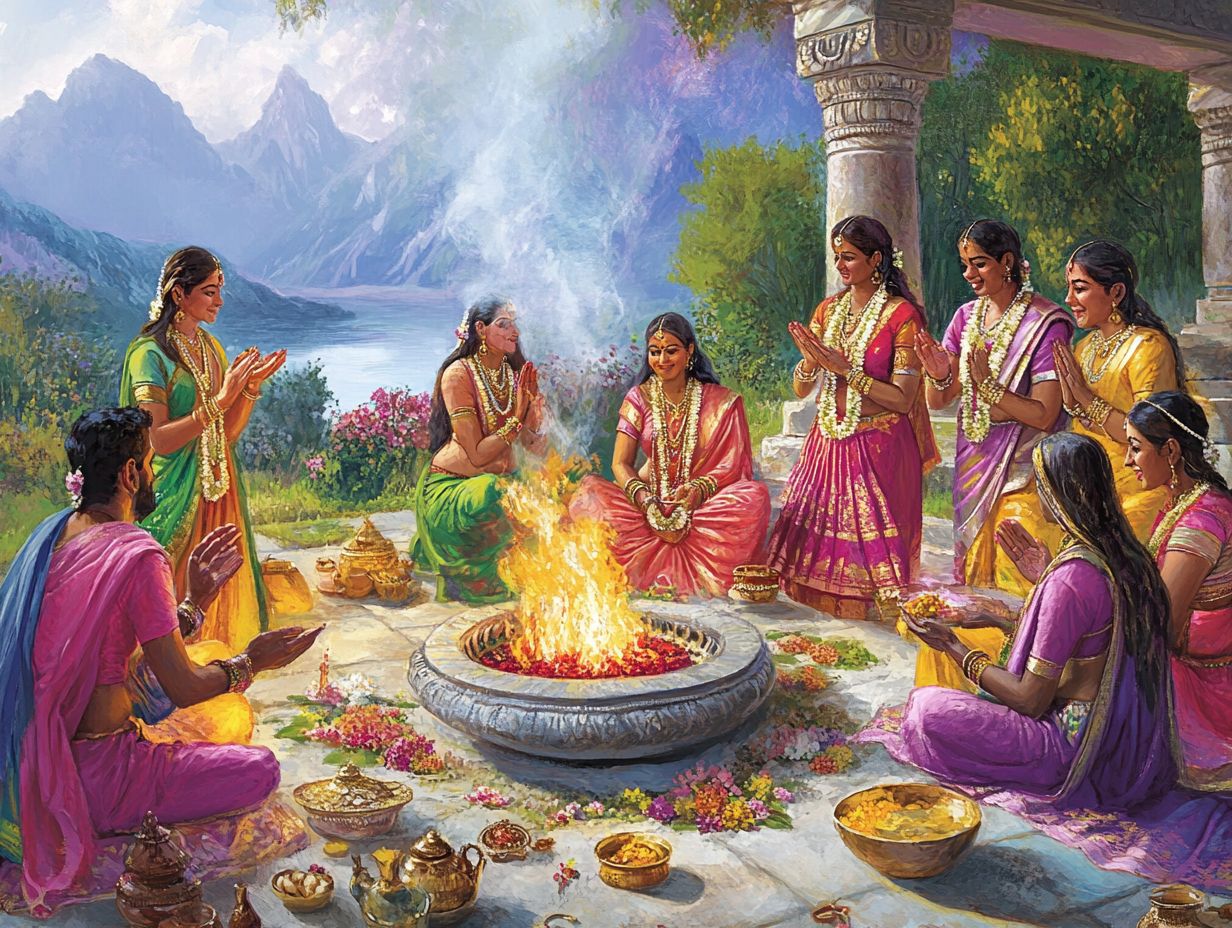How Do Hindus Call Hinduism?
Hinduism, recognized as one of the world s oldest religions, presents a complex tapestry of beliefs, practices, and philosophies that have undergone significant evolution over millennia. While it is commonly referred to simply as “Hinduism,” this designation encompasses a myriad of names that reflect its rich and diverse traditions, such as Sanatana Dharma and Vedic religion.
This exploration delves into the origins of the term “Hinduism,” shedding light on the importance of alternative names such as Sanatana Dharma and Vaidika Dharma. These terms encapsulate the fundamental beliefs, Dharma, and values that define the faith.
Embarking on this enlightening journey reveals the intricate terminology and profound philosophy that shape the Hindu identity, including concepts like atman and Brahman, inviting deeper understanding and appreciation of this ancient tradition.
What is Hinduism?

Hinduism, often referred to as Sanatana Dharma, stands as one of the world’s oldest and most intricate religions, profoundly rooted in the Vedic tradition. It encompasses a vast array of beliefs, spiritual practices, rituals, and ethical values that capture the essence of Hindu culture.
From the veneration of diverse gods and goddesses to the exploration of concepts like karma, samsara, and moksha, Hinduism transcends mere belief; it represents a holistic way of life. The teachings enshrined in revered texts such as the Vedas, Upanishads, and Bhagavad Gita illuminate the path for practitioners seeking spiritual enlightenment and fostering community engagement.
This rich tradition weaves together a vibrant tapestry of practices and customs, continually evolving while remaining firmly anchored in its ancient heritage.
|||
What is Hinduism?
Hinduism, often referred to as Sanatana Dharma, stands as one of the world’s oldest and most intricate religions, profoundly rooted in the Vedic tradition. It encompasses a vast array of beliefs, spiritual practices, rituals, and ethical values that capture the essence of Hindu culture.
From the veneration of diverse gods and goddesses to the exploration of concepts like karma, samsara, and moksha, Hinduism transcends mere belief; it represents a holistic way of life. The teachings enshrined in revered texts such as the Vedas, Upanishads, and Bhagavad Gita illuminate the path for practitioners seeking spiritual enlightenment and fostering community engagement.
This rich tradition weaves together a vibrant tapestry of practices and customs, including yoga and meditation techniques, continually evolving while remaining firmly anchored in its ancient heritage.
Hinduism, often referred to as Sanatana Dharma, stands as one of the world’s oldest and most intricate religions, profoundly rooted in the Vedic tradition. It encompasses a vast array of beliefs, spiritual practices, rituals, and ethical values that capture the essence of Hindu culture.
From the veneration of diverse gods and goddesses to the exploration of concepts like karma, samsara, and moksha, Hinduism transcends mere belief; it represents a holistic way of life. The teachings enshrined in revered texts such as the Vedas, Upanishads, and Bhagavad Gita illuminate the path for practitioners seeking spiritual enlightenment and fostering community engagement.
This rich tradition weaves together a vibrant tapestry of practices and customs, continually evolving while remaining firmly anchored in its ancient heritage.
What is the Origin of the Term “Hinduism”?
The designation ‘Hinduism’ emerged as a label for a diverse array of religious, philosophical, and cultural practices deeply rooted in the traditions of the Indian subcontinent. This term encapsulates a complex identity that transcends the notion of a singular religion.
Its origins can be traced back to the ancient civilizations that thrived along the banks of the Indus River, evolving over centuries through interactions with a multitude of cultures, religions, and social structures. As a result, a rich tapestry of beliefs and practices, including Hindu mythology and symbolic representations, has developed, which is acknowledged and celebrated in contemporary discourse.
Where Does the Word “Hindu” Come From?
The term ‘Hindu‘ originates from the Sanskrit word ‘Sindhu,’ which initially referred to the Indus River and, by extension, to the peoples residing beyond its banks. This etymological journey embodies the historical interactions among diverse civilizations and their profound impact on the identity of those who practice Hinduism, weaving together the threads of language, geography, and culture, including influences from the Bhakti movement and Advaita Vedanta.
The transformation of ‘Sindhu’ into ‘Hindu’ signifies a remarkable evolution of a term that has accompanied the rich narratives of cultural heritage within the Indian subcontinent. As the Indo-Aryan migrations unfolded and Persian influences took hold, the term adapted, transcending its initial designation as a mere religious identity to encompass a comprehensive way of life, deeply rooted in centuries of tradition, philosophy, and ritualistic practices.
Throughout its extensive history, Hinduism has embraced ideas from various cultures while steadfastly preserving its core principles, resulting in a vibrant tapestry of beliefs and practices. This dynamic evolution exemplifies the resilience and adaptability of those who identify as Hindus, anchoring them firmly within a historical context while simultaneously engaging with the complexities of contemporary global society.
How Do Hindus Refer to Hinduism?
Hindus often utilize a variety of terminologies to articulate their religion, each reflecting the rich complexity of their beliefs and practices. Terms like Sanatana Dharma highlight the eternal essence of their values, while Vaidika Dharma underscores the importance of adhering to the Vedic texts that are central to Hindu philosophy.
Each of these terms encapsulates unique dimensions of Hindu identity, spirituality, and cultural heritage, illuminating the multifaceted nature of this ancient religion.
|||
How Do Hindus Refer to Hinduism?
Hindus often utilize a variety of terminologies to articulate their religion, each reflecting the rich complexity of their beliefs and practices. Terms like Sanatana Dharma highlight the eternal essence of their values, while Vaidika Dharma underscores the importance of adhering to the Vedic texts that are central to Hindu philosophy.
Each of these terms encapsulates unique dimensions of Hindu identity, spirituality, and cultural heritage, illuminating the multifaceted nature of this ancient religion, including its caste system, ethical values, and communal rituals.
Hindus often utilize a variety of terminologies to articulate their religion, each reflecting the rich complexity of their beliefs and practices. Terms like Sanatana Dharma highlight the eternal essence of their values, while Vaidika Dharma underscores the importance of adhering to the Vedic texts that are central to Hindu philosophy.
Each of these terms encapsulates unique dimensions of Hindu identity, spirituality, and cultural heritage, illuminating the multifaceted nature of this ancient religion.
1. Sanatana Dharma

Sanatana Dharma, often regarded as synonymous with Hinduism, translates to ‘eternal religion’ and embodies the timeless and universal principles that guide the spiritual journey of its adherents. This term is a profound encapsulation of the philosophical and ethical framework that has emphasized righteousness, duty, and spiritual evolution through the ages, including the practices of yoga philosophy and meditation.
At its essence, this enduring tradition inspires individuals to nurture an intrinsic connection with the divine while fostering a profound respect for the interconnectedness of all living beings. By advocating values such as compassion, non-violence, and dharma understood as righteous living it presents a comprehensive approach to navigating the complexities of life.
This framework underscores the importance of personal responsibility and ethical conduct, urging practitioners to make meaningful contributions to their communities and the world at large. Consequently, the understanding of Sanatana Dharma transcends mere religious practices, embodying a holistic perspective on life that resonates across diverse cultures and epochs.
2. Vaidika Dharma
Vaidika Dharma specifically pertains to the religious practices and teachings derived from the Vedas, the revered scriptures of Hinduism, emphasizing the critical role of rituals and ceremonies in the spiritual lives of Hindus. This concept highlights the importance of adhering to Vedic principles, including sacred chants, as a means of nurturing a profound connection with the divine.
At the heart of Vaidika Dharma lies the conviction that these ancient texts not only provide guidelines for individual worship but also shape the communal and cultural practices that unite followers. The intricate tapestry of rituals rooted in the Vedas elevates the act of devotion, enabling practitioners to engage with transcendent themes such as dharma, karma, and moksha in their daily lives.
By following the structured framework established by these scriptures, individuals can adeptly navigate the complexities of modern spiritual demands while honoring the traditional paths that have been embraced for millennia.
3. Arya Dharma
Arya Dharma, which translates to ‘noble religion,’ underscores the ethical and moral values that form the bedrock of the Hindu belief system, advocating for a lifestyle deeply rooted in virtue and righteousness. This term encapsulates the aspirational qualities that practitioners of Hinduism strive for in their spiritual journeys and communal lives.
At its core, the principles of Arya Dharma serve as a guiding beacon for individuals, urging them to embrace lives defined by truthfulness, compassion, and respect for all living beings. By adhering to these moral tenets, practitioners increasingly align themselves with the collective welfare of society, cultivating an environment where kindness and justice reign supreme.
This commitment not only shapes personal conduct but also influences interactions within the community, as the values inherent in Arya Dharma inspire a profound sense of duty towards both family and the broader social fabric.
Ultimately, Arya Dharma acts as a catalyst for social harmony and fosters a deeper understanding of interconnectedness among all individuals, reinforcing the significance of ethical living in the quest for spiritual fulfillment.
4. Bh rata Dharma
Bh rata Dharma, deeply rooted in the cultural and historical tapestry of India, embodies the distinct expression of Hindu beliefs and practices that have evolved over millennia within Indian society. This term encapsulates the intricate relationship between religion and the rich cultural heritage, societal values, and communal rituals prevalent in the region.
It permeates various facets of daily life, influencing family structures, ethics, festivals, and art forms, and represents a harmonious fusion of divine principles with the lived experiences of the people. The core tenets of dharma underscore duty, righteousness, and moral responsibility, serving as a guiding compass for individuals navigating their personal and communal lives.
In turn, Indian culture has continually enriched these principles, emphasizing the significance of respecting nature, honoring ancestors, and pursuing knowledge. By examining these interconnections, one can gain a deeper appreciation of how Hinduism not only exerts a profound influence but is also dynamically shaped by the evolving social landscape of the country.
5. Hind Dharma
Hind Dharma embodies the self-identification of practitioners within the Hindu faith, embracing the rich diversity of beliefs and practices that define this dynamic religion. This concept underscores the profound personal connection individuals establish with their spiritual journeys, as well as the communal identity nurtured within Hindu society.
The importance of Hind Dharma transcends mere belief systems; it actively shapes both personal identities and collective experiences among its followers. This intricate tapestry of philosophies, rituals, and religious diversity provides individuals with the opportunity to explore their spirituality through various paths, fostering a deep sense of belonging and community.
Festivals, rituals, and family traditions emerge as vital expressions of this identity, weaving strong bonds among community members. Despite the myriad interpretations of sacred texts and the diverse regional practices, a shared commitment to core principles such as karma and moksha reinforces a robust communal fabric.
As a result, Hind Dharma not only promotes individual growth but also fortifies the connections that unite diverse practitioners, celebrating the vibrant spectrum of this esteemed tradition, including its ethics, beliefs, and spiritual practices.
6. Sanaatana Dharma
Sanaatana Dharma, closely related to Indian philosophy and Hinduism, underscores the eternal principles that shape the moral and spiritual framework of Hindu beliefs. This concept reinforces the understanding that Hinduism transcends a mere collection of rituals; instead, it represents a profound philosophical journey toward truth and comprehension.
At its essence, this belief system invites individuals to delve into their inner selves, embarking on a transformative journey toward self-realization while highlighting the interconnectedness of all life. Through its teachings, practitioners are inspired to uphold values such as non-violence, compassion, and respect for all beings, which illuminate their spiritual endeavors.
Sanaatana Dharma calls upon individuals to acknowledge the eternal truths that surpass the confines of time and culture, serving as a reminder of the significant impact of their actions and the necessity of knowledge in achieving both personal and collective enlightenment. Thus, the core of Hindu thought transcends mere dogma, advocating for a comprehensive approach to spirituality.
7. Vaidik Dharma

Vaidik Dharma underscores the importance of adhering to the teachings and rituals delineated in the Vedas, which are the bedrock of Hindu ritual and philosophy. This concept embodies a steadfast commitment to the traditions that have been meticulously preserved through generations, nurturing a profound spiritual connection.
For contemporary practitioners, grasping the essence of Vaidik Dharma is essential for maintaining ties to their heritage amidst the complexities of modern existence. The Vedas not only offer guidelines for rituals that foster community cohesion and individual spirituality but also function as a moral compass. Rituals derived from these sacred texts provide individuals with opportunities to engage with the divine and channel positive energies into their daily lives.
As practitioners weave these ancient teachings into their modern expressions of worship, they discover relevance and renewed purpose, ensuring that the practice remains both vibrant and meaningful across generations. The importance of yoga and meditation in Vaidik Dharma also highlights the integral role these practices play in achieving spiritual growth.
What is the Meaning of Sanatana Dharma?
Sanatana Dharma, which translates to ‘eternal law,’ encapsulates the timeless principles that govern both human existence and spirituality within Hinduism. This profound concept includes multiple dimensions of philosophy, ethics, and spirituality, serving as a guiding beacon for adherents as they navigate the path toward a righteous and meaningful life. The teachings found in sacred texts such as the Upanishads and the Bhagavad Gita play a crucial role in elucidating these principles.
What is the Significance of Vaidika Dharma?
Vaidika Dharma holds a pivotal position in the spiritual landscape of Hinduism, offering a foundational framework deeply anchored in the Vedas, which are revered as the supreme authority in matters of faith and spirituality.
This profound significance is evident in the strong emphasis placed on rituals and practices designed to forge a connection between individuals and the divine, including puja and other forms of worship.
What is the History of Arya Dharma?
The history of Arya Dharma is intricately woven into the fabric of Hindu ethical values and societal structures, mirroring the dynamic shifts in beliefs that have occurred over centuries.
As a guiding principle for righteous living, Arya Dharma has cultivated a profound sense of moral responsibility and spiritual growth within the Hindu community, shaping its ethical landscape and enriching its cultural heritage. The influence of the caste system and other societal structures is also an essential aspect of Arya Dharma’s history.
What is the Importance of Bh rata Dharma?
Bh rata Dharma serves as a crucial lens for comprehending the intricate relationship between Hinduism and India’s rich cultural tapestry. It encapsulates the distinctive expressions of beliefs and practices that shape Hindu identity, including Hindu life cycle events like birth, marriage, and death.
This significance underscores the seamless integration of religion with societal values, traditions, and cultural practices, highlighting the profound influence of Bh rata Dharma in the ongoing dialogue between faith and the diverse cultural fabric of the nation.
What is the Symbolism of Hind Dharma?
The symbolism of Hind Dharma is both rich and multifaceted, capturing the diverse beliefs and practices that define Hindu identity.
Sacred symbols such as Om and the Swastika, alongside a myriad of rituals and community gatherings, each serve as profound reminders of the spiritual journey and cultural heritage that shape the lives of Hindus. Additionally, sacred texts like the Vedas and Bhagavad Gita play a significant role in guiding these practices.
What is the Philosophy Behind Sanaatana Dharma?

The philosophy underpinning Sanaatana Dharma is deeply embedded in the comprehension of eternal values that rise above mere temporal existence, directing practitioners on a path toward spiritual enlightenment and ethical living.
This rich philosophical framework inspires individuals to explore knowledge and truth within the intricate tapestry of Hindu beliefs, fostering a profound connection to the principles that govern both the cosmos and the self. Teachings from the Bhakti movement and Advaita Vedanta further enrich this philosophical foundation.
How Do These Terms Reflect the Beliefs of Hinduism?
The myriad terms used to characterize Hinduism such as Sanatana Dharma, Vaidika Dharma, and Arya Dharma serve as a testament to the rich tapestry of beliefs and practices that define the spiritual landscape of this religion.
Each term emphasizes distinct facets of Hindu philosophy, spirituality, and cultural identity, illuminating the intricate complexities of this ancient faith. These terms also highlight the diversity of Hindu sects and traditions, ranging from temple worship to yoga and meditation.
Frequently Asked Questions
What is the proper name for the Hindu religion?
The proper name for the Hindu religion is Hinduism, which is derived from the Sanskrit word “Hindu” meaning “river”. It encompasses a wide range of beliefs, practices, and traditions, including the Vedic religion and Brahmanism.
How do Hindus refer to their religion in their native language?
In India, Hindus refer to their religion as “Sanatana Dharma” which translates to “Eternal Law” or “Eternal Way”. This term encompasses the moral, ethical, and spiritual dimensions that guide practitioners in their daily lives.
What other names are used to describe Hinduism?
Hinduism is also known as Vedic Dharma, Brahmanism, and the Sanatana Dharma. These terms reflect the evolution and diversity of Hindu beliefs and practices over millennia.
What is the significance of the term “Hindu” in relation to the religion?
The term “Hindu” was originally used by outsiders to refer to the people living beyond the Indus River. It later became associated with the religion practiced by these people, encapsulating the rich tapestry of Hindu beliefs, rituals, and cultural practices.
Why is Hinduism often referred to as a way of life rather than just a religion?
Hinduism encompasses a diverse set of beliefs, practices, and traditions that are not limited to religious rituals. It is considered a way of life that encompasses all aspects of an individual’s existence, including moral codes, social responsibility, and environmental ethics.
How has the name of the religion evolved over time?
The name of the religion has evolved from the ancient term “Sanatana Dharma” to “Hinduism” in modern times. This change reflects the evolution of the religion and its influence on different cultures and societies. The historical influences of various dynasties, sects, and spiritual leaders have also shaped its modern form.
